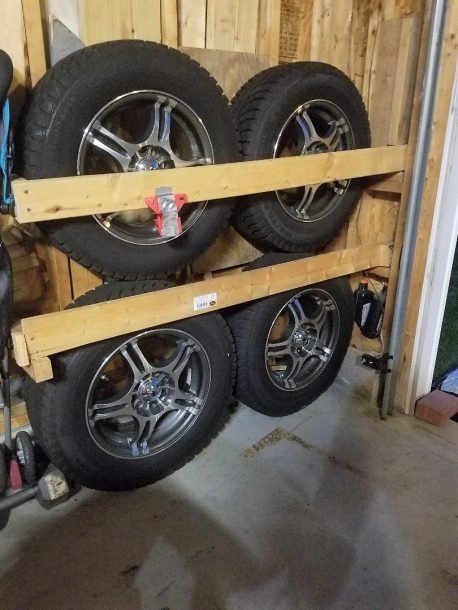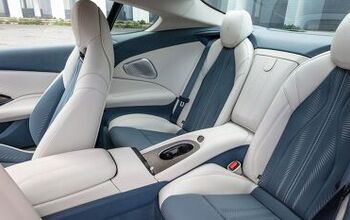Winter Tires - Are They Worth It?
Our 1985 Nissan Maxima was heading south on 219 from Niagara Falls at 70 mph. The Falls are beautiful in winter, but of course traveling through New York at that time of year can mean bad roads. My dad was behind the wheel and, with no snow in sight, he was confidently chauffeuring us home to the Carolinas. That’s when he turned to my mom and said, “I wonder if this is black ice we’re driving on? Let me tap the brakes and see.”
“Dad! WooHoo!” I grabbed onto the silver metal posts holding his head rest up with both hands. That tap of the brakes had sent the tail of our Maxima suddenly passing the front of the car for the lead. Of course, as a kid I was safely buckled into a child seat. That is, if by child seat you mean we had the seats folded flat and sleeping bags spread out so we could lay down and play. Oh, the 1980s.
“Daaad!” I was still convinced at this point in my life my dad could do anything, which would include throwing our family sedan into a 360-degree spin on the highway on purpose. As cool as the first spin was, I was ready for it be over. What with the semi truck barreling towards us from behind and all.
“Daaaaad!” As if my yelling would help him saw any faster at the wheel in a failed attempt to recover. The OEM all-season tires did nothing to slow us or stop us from doing three full revolutions down the highway. Miraculously, we avoided all guard rails and ditches, and spun for such a long distance that the semi could come to a full stop behind us, protecting us from other traffic.
The “Miracle on 219” helped cement my faith in God, but left my mom with a serious fear of winter driving. Nowadays, I try each year to convince her to put winter tires on my parents’ cars but to no avail. After attending a recent Tire Rack/Michelin Winter Driving Experience, I now have the actual data to show her (and you, dear reader) the merits of using winter tires. Perhaps we could have used them on our old Maxima?
Full disclosure: Michelin and Tire Rack paid for my travel, room, and board. Tire Rack calls itself America’s largest independent tire tester and consumer-direct source for tires and wheels. In addition to testing winter tires on ice rinks, they also have a test track on-site at their South Bend, Indiana facility they use when it is snow covered, and take a trip to the Arctic Circle each year to test in northern Sweden.
First off, they are “winter” tires, not “snow” tires. And second, they aren’t for everyone. Looking at the map below, you can see the areas of the U.S. that tirerack.com recommends for winter-tire usage (the dark areas). Tire manufactures like Michelin say if the temperature where you live consistently stays below 44 degrees (Fahrenheit) during the winter, then winter tires will help.
The biggest misconception is that winter tires are only for snow. There are two main differences between a winter tire and all-season tire. Tread depth/design and rubber compound. Of course the tread depth and extensive grooves are great for moving snow and slush. But the rubber compound also makes a huge difference.
A summer tire begins to lose performance and traction at temperatures below 60 degrees F as the rubber hardens. An all-season tire stays soft and sticky at a much lower temperature but most will begin losing traction performance below 40 degrees F. Colder temps reduce a tire’s flexibility and grip, meaning winter tires will outperform an all-season tire on dry pavement at temperatures beginning as high as 40 degrees. That means it doesn’t need to snow for you to realize the benefits and safety of driving on winter tires. The makeup of a typical winter tire stays soft, flexible, and grippy well below freezing, allowing it to hug the frozen yet dry roads.
Living in Columbus, Ohio, I was already a believer in winter tires when I experienced the night-and-day difference they made on my Honda Fit. Winter tires have come a long way over the last few years. No longer are winter tires a compromise to drive on the occasional 70-degree February day.
In fact, tests show most winter tires perform equally to a comparable all-season tire in hot weather. A winter tire will wear slightly faster in warm weather though, so it’s still best to keep an extra set of wheels/tires for the nicer months. Here are the most common excuses for why someone doesn’t use winter tires, along with the data from our tests that proves them wrong.
PS: Anyone want to guess what percentage of cars in the dark area of the map at the top actually use winter tires? I’ll answer in the comments.
1. I Have All-Wheel Drive
The tests we did involved using the University of Notre Dame’s hockey stadium to compare two otherwise identically prepared vehicles that were equipped with different tires, on ice. One had Michelin X-ICE Xi3 (for cars) or Xi2 (for SUVs/trucks), and the other had the factory all-season tires. First, we drove all-wheel drive Kia Sportages with both winter and all-season tires. The goal was to see how fast we could get the vehicle to go in 70 feet.
THE RESULTS
What that means in the real world is driving an all-wheel-drive vehicle with all-season tires would take about three seconds longer to cross an intersection that had some ice than the same vehicle with winter tires. If you are making a left with oncoming traffic coming and don’t know there is ice on the pavement, that three seconds is huge. Even with all-wheel drive and traction control on and new tires, the performance was still not sufficiently close to that of the same car with winter tires.
2. They Cost Too Much
The current average length of ownership of a new car is six years (five years for a used car). With a 60,000 mile all-season tire from the manufacturer, you’ll likely be replacing your tires at year four. However, if you were alternating those with a winter set, you can go well over seven years on your original set of tires. So in seven years of ownership you would only have had to purchase one set of tires for your vehicle, but you would have enjoyed the best in safety and handling in all situations. Especially if you were alternating with a summer tire.
How much is your deductible? $500-$1,000 for most folks. I was able to buy a set of wheels and winter tires for around $600 for my Fit.
Bringing the Kia Sportages to a stop showed another huge difference between tire compounds on the ice. If you can avoid even just one fender bender by coming to a stop in a shorter distance, how much would that save you? Not to mention your insurance rates not going up, and not having to use vacation days when you can’t drive to work due to weather.
I saved additional money by purchasing a -1″ wheel and a tire with a taller sidewall. The smaller wheel/tire combination saved me hundreds on my Fit, provided a softer ride, and more protection from potholes in the winter.
THE RESULTS
The difference is more than the length of two cars. At 20 mph. That stopping distance will grow exponentially with increased speed, so imagine what it is at highway speeds. I don’t have to. I’ve been backwards at 70 mph on the highway once and that was enough for me. I’m confident that little tap of the brake my dad did would have resulted in nothing with winter tires on. At least we were lucky. Michelin claims their winter tires offer up to 50 percent more winter traction than all-season tires in cold temperatures.
3. It’s Too Much of a Hassle
Knowing I’m supposed to rotate my tires at least every six months, I just arrange to do it when it’s time to swap tires. Most shops will not charge you to instead put on winter tires as opposed to doing their free tire rotation. Storage an issue? Stacking four tires is about the size of two rubber totes. Here is my set up:
Next we drove equally prepared front-wheel drive Kia Cadenzas with either all-season or winter tires. This was set up as a drag race.
THE RESULTS
A real hassle would be taking nine seconds just to get to 10 mph with new tires on. You can image the dangerous situations that can present while trying to pull out onto any street with ice.
4. Traction and Stability Control are Enough
See the pictures below as a visual demonstration of the turning abilities of an all-season tire compared to a winter tire on ice. We were traveling at 10 mph attempting to make a slow 90-degree turn, the kind you would see in a neighborhood, while avoiding the row of cones. Even traveling that slow and knowing we were on ice the results were staggering. The first vehicle with all-season tires repeatedly skidded well off course. If this were a neighborhood, the all-wheel drive Sportage with all-seasons on would be over the curb and through the front yard. Image how much more drastic the difference in turning abilities on ice would be at a higher speed. The winter tires did not even slip.
Coming to this event I was hoping to have an “ah-ha” moment where it really proved to me that winter tires are worth the expense. I had numerous such moments. The bottom line is that if you experience most of your winter with temps under 44 degrees F and are at all concerned with things like stopping, accelerating, and steering, then you will benefit from having winter tires. Data from the National Highway Traffic Safety Administration shows that wintery weather accounted for more than 681,000 crashes in 2012. Using winter tires extends the life of your other tires so price becomes almost a non-factor. Winter tires aren’t for everyone, but as for my family and I, we will drive with winter tires.
Also, if your tires suck and you’re shopping for new tires, help support TTAC’s work by doing your research at TireReviewsandMore.com. — TTAC Staff
More by Matt Fink
Latest Car Reviews
Read moreLatest Product Reviews
Read moreRecent Comments
- ToolGuy 9 miles a day for 20 years. You didn't drive it, why should I? 😉
- Brian Uchida Laguna Seca, corkscrew, (drying track off in rental car prior to Superbike test session), at speed - turn 9 big Willow Springs racing a motorcycle,- at greater speed (but riding shotgun) - The Carrousel at Sears Point in a 1981 PA9 Osella 2 litre FIA racer with Eddie Lawson at the wheel! (apologies for not being brief!)
- Mister It wasn't helped any by the horrible fuel economy for what it was... something like 22mpg city, iirc.
- Lorenzo I shop for all-season tires that have good wet and dry pavement grip and use them year-round. Nothing works on black ice, and I stopped driving in snow long ago - I'll wait until the streets and highways are plowed, when all-seasons are good enough. After all, I don't live in Canada or deep in the snow zone.
- FormerFF I’m in Atlanta. The summers go on in April and come off in October. I have a Cayman that stays on summer tires year round and gets driven on winter days when the temperature gets above 45 F and it’s dry, which is usually at least once a week.











































Comments
Join the conversation
I'm going to take exception to this 10 year tire life claim. Are you kidding me?
Been using winter tires for nearly 20 years. Had a spinout once and that was it. Not only did I invest in winter rubber, I bought the best tires I could get. It really is a life saver, especially where I live since they rarely clear the roads and we don't use salt.